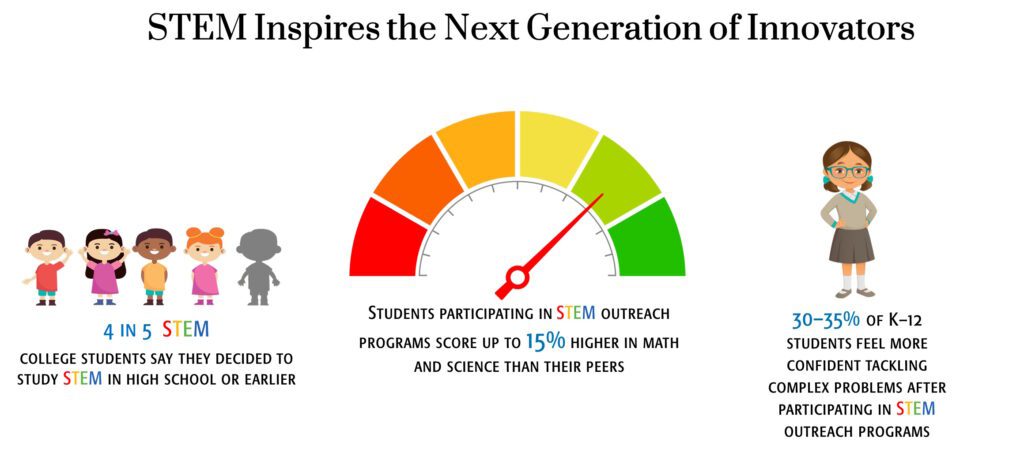
Science, Technology, Engineering, and Mathematics (STEM) are more than just academic subjects; they are the bedrock of modern society and the engine of future progress. From developing life-saving vaccines and sustainable energy solutions to creating the smart technologies that shape our daily lives, STEM fields drive innovation across every sector.



- MOVE uses Signal & Communication Scientists to detect, locate, and secure digital signals for the MOVE trucks
- Automotive Scientists & Engineer transformed the MOVE trucks into disaster recovery vehicles
- Industrial Engineers design, develop, implement, and evaluate all the systems on the MOVE trucks
- MOVE uses Web Developers design, develop, and maintain the MOVE website
- System Architects code, test, implement and improve all the software used by the MOVE trucks
- Radio Engineers install, maintain, and repair the radio and transmission equipment on the MOVE trucks
- MOVE uses Mechanical Engineers to design, analyze, and maintain the solar panels and frame that secures and deploys the satellite dishes on the MOVE trucks.
- MOVE uses satellites designed by Aerospace Engineers to stay connected, forecast the weather, and get to and from deployments.
- MOVE works with Electrical Engineers in restoring and enhancing critical infrastructure, ensuring rapid recovery and resilience in affected communities.
How MOVE Uses Math STEM Skills
- MOVE uses Accountants to manage financial documents, keep track of spending, and forecast budgets.
- MOVE uses Atmospheric Scientists who utilize math to predict the weather. MOVE utilizes those forecasts to ensure safe travel and allocate resources.
- MOVE uses Resource Managers to calculate everything from how long it will take to arrive at a destination to how much the truck weighs.
STEM in Everyday Objects
STEM in Our Structures
STEM in Nature
STEM in Our Homes




Consider the devices we use constantly. Your smartphone, for instance, is a marvel of STEM. Science explains how its touchscreen works through electrical conductivity and how light is emitted from its display. Technology encompasses the intricate microchips, the operating system that runs your apps, and the wireless communication protocols like Wi-Fi and Bluetooth that connect you to the internet. Engineers meticulously designed its physical structure, from the camera lens to the durable casing, and developed its battery technology for extended use. Finally, mathematics is the hidden language behind everything, from data compression that makes images load quickly to the algorithms that power your favorite social media feeds.
The structures we inhabit and the ways we travel are also testaments to STEM. When you look at a building or a bridge, you’re seeing the direct application of science in material properties like the strength of steel and concrete, and engineering in the architectural design and structural integrity that allows them to withstand forces like gravity and wind. Civil engineers are behind the roads we drive on and the complex systems that manage our water and electricity. Technology provides us with tools like computer-aided design (CAD) software, while mathematics is crucial for precise measurements, angle calculations, and ensuring these structures can bear their intended loads and stay within budget. Even the vehicles we use, from cars to planes, rely on aerodynamics, combustion physics, and intricate engineering designs to transport us safely and efficiently.
Beyond man-made creations, STEM helps us understand the natural world and our own bodies. Science explains the water cycle, the growth of plants through photosynthesis, and the intricate workings of ecosystems. Technology aids us in understanding weather patterns through forecasting models and in monitoring environmental changes via satellite imagery. Engineers develop solutions for sustainability, like designing renewable energy systems such as solar panels and wind turbines, and creating processes for waste management. In terms of our health, biomedical engineers design everything from artificial limbs to advanced medical devices, while scientists continually research new medicines and treatments. Mathematics is essential for analyzing health data, calculating medicine dosages, and understanding disease spread, making our well-being deeply intertwined with STEM.
Step into any modern home, and you’re surrounded by sophisticated systems and appliances that seamlessly blend STEM principles. Take your refrigerator, for instance. At its core, science explains the principles of thermodynamics and how refrigerants absorb and release heat to keep your food cold. Technology manifests in its precise temperature controls, energy-efficient insulation, and perhaps even smart features like touchscreens and internet connectivity. Engineers are responsible for designing every aspect, from the compressor and condenser coils to the layout of shelves and the efficiency of the seals, ensuring optimal performance and energy saving. They also design the manufacturing processes that produce these complex units. Finally, mathematics is crucial for calculating energy consumption, optimizing internal airflow for even cooling, precisely programming the defrost cycles, and even determining the most efficient shapes for ice makers or internal compartments. From the smart thermostat regulating your climate to the microwave oven heating your food, our homes are fundamentally engineered spaces, built upon scientific principles, enabled by technology, and meticulously designed with mathematical precision.

